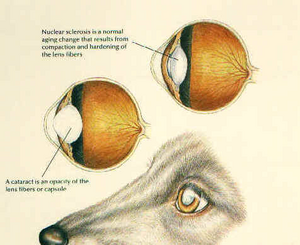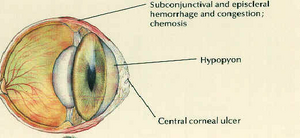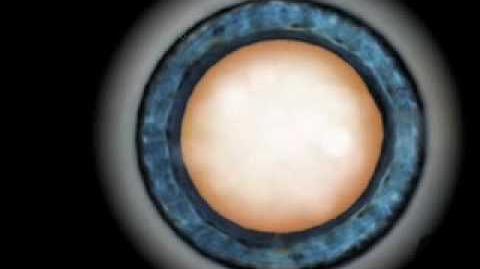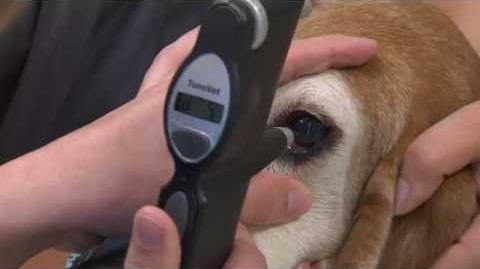Cataracts are a frequent occurrence in diabetic dogs, less frequent in diabetic cats. Hyperglycemia in dogs can cause both cataracts and retinopathy; cataracts can cause blindness in a few days or weeks. Blood glucose levels of 250mg/dL (14.0 mmol/L) and above can cause cataracts in dogs.[1]
Diabetic retinopathy is a special case of neuropathy in the optic nerve and retina, and is caused by high blood sugar. Glucose toxicity damages blood vessels that nourish the retina at the back of the eye. This progressively results in blurred vision. Diabetic retinopathy has been identified in animals with diabetes. It's an unusual finding in animals; however, unlike the diabetic retinopathy of human diabetes, it rarely is a threat to vision. [2][1]
Mechanisms of cataracts in dogs[]

The difference between cataracts and nuclear sclerosis (part of the aging process) can be seen by comparing the changes in the lens.[3]
Cataracts in diabetics are caused by high blood sugar. A cataract is an opacity in the lens of the eye. The entire lens may be involved or just a part of it. The patient will not be able to see through the opacity.
The eye fluids normally contain some amount of glucose, which the lens uses to nourish its cells. When the eye fluids contain too much glucose, some is converted to sorbitol, which is absorbed by the lens but cannot be consumed. [4] The lens becomes hypertonic and pulls extra water into the lens, which damages it and makes it lose transparency.[1] This damage to the lens is permanent, though lens replacement implants are possible. Cataract removal surgery is possible without the use of replacement lens implantation.
Despite what some "health sites" on and off the internet claim, at present there is no medication to dissolve cataracts; [5] removal by a veterinary opthalmologist is the only answer. [6] Currently, cataract surgery has a success rate of over 90%. [7]
There is, however, a new drug which is being tested that may prevent the formation of cataracts in diabetic dogs and to reverse early cataract formation.[8][2]
Other Diabetic Eye Problems[]

Illustration of a corneal ulcer.
Dogs with diabetes have more "at risk" eye problems, other than cataracts and blindness. They can be prone to recurring or nonhealing ulcers of the eyes. This 2003 study found that dogs with diabetes have significantly reduced sensitivity of their corneas. This means that the nerves of the corneas do not function normally. The study indicates this to be true no matter what the glycemic control is and length of time with diabetes. [9][1]
Dry Eye[]
Dogs with diabetes, Cushing's disease, and hypothyroidism can tend to produce less than normal amounts of tears, [10] which is commonly known as dry eye. [11][12] The eyes generally have a thick, yellowish discharge. Without the normal amount of tears to keep them at bay, infections commonly develop. Not having the right amount of lubrication in the form of tears, there's no way to wash away things like dust and pollen.[1]
Without treatment (which is replacement of the lost lubrication), chronic and often painful eye infections can develop.[13] The continual irritation of the cornea can result in corneal ulcers, scarring of the cornea and even permanent loss of sight. [14]
Glaucoma[]
If your diabetic pet is also dealing with glaucoma, see Medication warnings for information about how drugs used in treatment of glaucoma may mean trouble with diabetic control. ![]()
References[]
- ↑ 1.0 1.1 1.2 1.3 1.4 Plummer, Caryn E., Specht, Andrew, Gelatt, Kirk N. (December 2007). Ocular Manifestations of Endocrine Disease. Compendium.
- ↑ 2.0 2.1 The Diabetic Eye. SouthPaws (2008).
- ↑ Corby, Kim, Holbrook, Todd (2005). Geriatric Changes in Cats and Dogs. VetLearn.
- ↑ Cataracts in Dogs. Pet Education.
- ↑ Ketring, Kerry. "Miracle" Cataracts Cures Without Surgery. All Animal Eye Clinic.
- ↑ Cataracts. American College of Veterinary Opthalmologists.
- ↑ Cataracts. American College of Veterinary Opthalmologists.
- ↑ Ophthalmology Clinical Trial: Medical Treatment for Cataracts in Diabetic Dogs. Iowa State University School of Veterinary Medicine.
- ↑ Kathryn L. Good, DVM David J. Maggs, BVSc Steven R. Hollingsworth, DVM Randall H. Scagliotti, DVM, MS Richard W. Nelson, DVM (2003). Corneal sensitivity in dogs with diabetes mellitus. American Journal of Veterinary Research.
- ↑ Williams DL, Pierce V, Mellor P, Heath MF. (2007). Reduced tear production in three canine endocrinopathies. Journal of Small Animal Practice.
- ↑ Dry Eye. ProVet UK.
- ↑ Dry Eye and Endocrine Diseases. NAVC (November 2007).
- ↑ Chronic Corneal Diseases--Dry Eye. NAVC (December 2004).
- ↑ Dry Eye in Dogs. Pet Education.
More Information[]
- Find a Board-Certified Opthalmologist American College of Veterinary Opthalmologists-ACVO
- Cataracts in the diabetic dog MarVista Vet
- Non-steroidal anti-inflammatories prevent retinopathy in diabetic dogs Gardiner TA, Anderson HR, Degenhardt T, Thorpe SR, Baynes JW, Archer DB, Stitt AW., 2003, Diabetologica
- Keratoconjunctival Effects of Diabetes in Dogs Cullen, Cheryl, et. al., 2005, Veterinary Opthalmology
- A Look at Some of the "Miracle Cures" for Canine Cataracts All Animal Eye Clinic-Dr. Kerry Ketring-Board-Certified-American College of Veterinary Opthalmologists
This 35 page pdf is absolutely current in its presentation of cataract "miracle cures" being marketed. - Effect of Chronic Hypertension on Renal Function in Dogs Bovee, Kenneth C., 2003, WSAVA
- Cataracts in Dogs Petplace.com
- Keratitis-of the Cornea Dorland's Medical Dictionary
- Conjunctiva Definition Dorland's Medical Dictionary
- Cataracts American College of Veterinary Opthalmologists
- Insuman Basal Patient Information Leaflet refers to human vision loss through severe hypos-EMC, UK
- Ocular Pharmacology Brooks, Dennis, 2005, WSAVA
- Ocular Manifestations of Systemic Hypertension in Dogs and Cats Hijar, Manuel Villagrassa, 2002, WSAVA
- Hypertension in Renal Diseases and Failure. The Practical Aspect Brovida, Claudio, 2002, WSAVA
- Diseases of the Lens in Dogs and Cats Peiffer, Robert L., Jr., 2004, WSAVA
- Conditions of the Lens Peterson-Jones, Simon M., 2003, WSAVA
- Cataracts Sapienza, John S., 2002, WSAVA
- Diabetic Cataracts: Different Incidence Between Cats & Dogs Salgado D, Reusch C, Spiess B., 2000, Schweizer Archiv fuer Tierheilkunde-Abstract in English
- For the Dry Eyes in the House North American Veterinary Conference
- Painful Ocular Lesion NAVC 2006
- Bacterial Corneal Disease in Dogs and Cats Clinicians' Brief 2004
- Microbiological and Clinical Aspects of Corneal Ulcers in Dogs A. Morales; M.A.R. Valinhos; M. Salvadego; C.E. Levy, 2009, WSAVA
- Corneal Ulcers in Dogs and Cats Dr. Ron Hines
- Ocular Manifestations of Systemic Disease in Small Animals Dennis E. Brooks, University of Florida School of Veterinary Medicine
- How to Administer Eye Drops and Ointments Nora Apothecary

